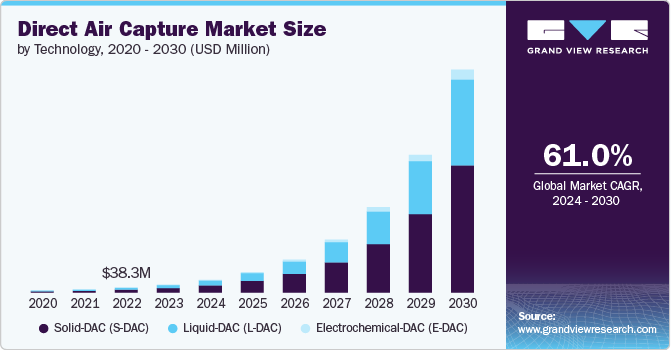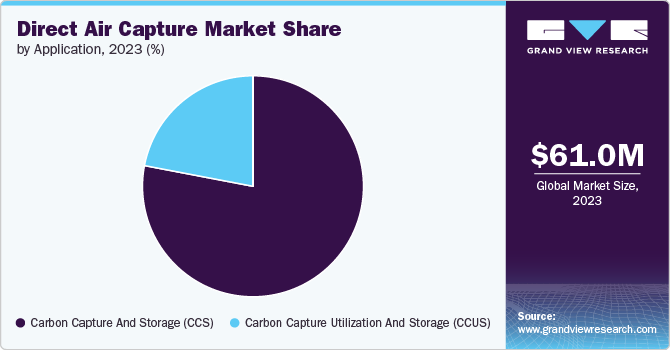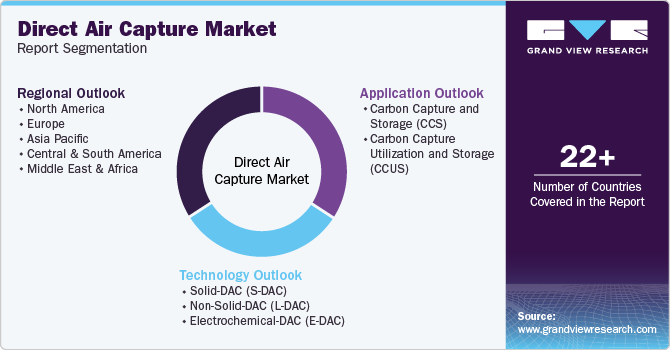
Direct Air Capture Market Size, Share & Trends Analysis Report By Technology (Solid-DAC (S-DAC), Non-Solid-DAC (L-DAC), Electrochemical-DAC (E-DAC)), By Application, By Region, And Segment Forecasts, 2024 - 2030
- Report ID: GVR-4-68040-465-6
- Number of Report Pages: 110
- Format: PDF, Horizon Databook
- Historical Range: 2018 - 2022
- Forecast Period: 2024 - 2030
- Industry: Energy & Power
Direct Air Capture Market Size & Trends
The global direct air capture market size was estimated at USD 61.0 million in 2023 and expected to grow at a CAGR of 61.0% from 2024 to 2030. The primary driver for the direct air capture (DAC) market growth is the increasing global awareness and urgency to mitigate climate change. Governments, industries, and organizations worldwide recognize the pressing need to reduce atmospheric CO₂ levels, one of the leading contributors to global warming. With the goals of the Paris Agreement aiming for net-zero emissions by mid-century, DAC technology offers a viable solution by capturing CO₂ directly from the air, which can then be stored or reused, significantly helping to offset carbon emissions.

Governments around the world are implementing policies to support DAC technologies as part of broader decarbonization strategies. For example, carbon pricing mechanisms, such as carbon taxes and cap-and-trade programs, make DAC an attractive option for industries seeking to offset emissions. Additionally, subsidies and grants are being introduced to encourage research, development, and scaling of DAC technologies. In the United States, for instance, tax credits such as the 45Q incentive are encouraging companies to invest in DAC as part of their carbon management plans.
Drivers, Opportunities & Restraints
One of the primary drivers of the DAC market is the global need to address climate change. DAC technology offers a method to capture carbon dioxide (CO₂) directly from the atmosphere, which is critical in reducing global greenhouse gas concentrations. Countries and industries worldwide are setting ambitious carbon reduction goals, such as achieving net-zero emissions by 2050, in line with international climate agreements. DAC is seen as an essential tool in achieving these targets, especially for sectors where reducing emissions is otherwise difficult.
Many corporations, particularly those in high-emission industries such as oil and gas, aviation, and manufacturing, are investing in DAC technologies as part of their sustainability and decarbonization strategies. With growing pressure from investors, regulators, and consumers, these companies are looking for ways to offset their carbon footprint. DAC offers a solution for capturing carbon that can be stored or utilized, helping companies meet their environmental goals while maintaining operational flexibility in hard-to-decarbonize areas.
One of the main restraints of the direct air capture (DAC) market is the high cost of operation, largely due to its energy-intensive processes. DAC systems require significant energy input to capture CO₂ from the atmosphere, particularly in comparison to point-source capture technologies like those used in industrial processes. This energy demand often results in higher operational costs, which can make DAC less economically attractive. Additionally, the cost of renewable energy or carbon-free electricity, necessary for making DAC truly sustainable, adds to the overall expenses.
The DAC market offers opportunities for transforming captured CO₂ into valuable products, creating new economic avenues. Captured carbon can be used in a variety of applications, such as the production of sustainable synthetic fuels, polymers, and construction materials like carbon-cured concrete. These carbon-to-value processes allow companies to not only reduce their carbon footprint but also generate new revenue streams from the captured CO₂. As demand grows for sustainable alternatives to traditional materials, DAC technology can be a key enabler of carbon utilization, driving its market appeal.
Technology Insights
The Solid-DAC (S-DAC) segment held the largest revenue share of 56.68% in 2023. Solid direct air capture utilizes solid sorbents, such as porous materials or chemical agents, to selectively capture CO₂ from ambient air. These solid materials have high surface areas, enabling them to efficiently absorb carbon dioxide when air is passed over them. One of the key trends in the solid DAC market is the focus on developing and optimizing new materials that can enhance CO₂ capture capacity while reducing costs. Researchers are working on advanced solid sorbents that not only have higher adsorption rates but are also more durable, allowing for longer operational lifespans and reduced maintenance costs. Another emerging trend is the integration of renewable energy sources, such as solar and wind, into solid DAC systems to further reduce their carbon footprint. This alignment with clean energy trends makes solid DAC an increasingly attractive solution for sustainable carbon removal efforts.
The liquid DAC market segment is expected to see significant growth, driven by increasing demand for carbon removal solutions across industries such as energy, manufacturing, and aviation. As industries face mounting pressure to meet carbon reduction targets, liquid DAC presents a scalable and efficient solution for capturing atmospheric CO₂. The potential to reuse captured CO₂ in industrial processes or convert it into valuable products, such as synthetic fuels and chemicals, is another factor driving interest in the liquid DAC segment. The market outlook for liquid DAC is positive, with continued government support, corporate investments, and technological advancements positioning it as a critical component in the global carbon removal landscape.
Application Insights
The carbon capture and storage segment held the largest revenue share of 78.42% in 2023. The increasing regulatory pressure to curb greenhouse gas emissions is a significant driver of the CCS segment. Governments are implementing stricter emissions targets, carbon pricing, and cap-and-trade programs, pushing industries to adopt carbon capture technologies to meet compliance. Furthermore, growing corporate sustainability commitments and the need to offset hard-to-abate emissions in sectors such as energy, cement, and steel are fueling demand for CCS solutions. Government incentives, such as the U.S. 45Q tax credit, which rewards companies for sequestering CO₂, also incentivize investment in CCS infrastructure and deployment.

Technological innovations in carbon capture and storage processes are improving the efficiency and cost-effectiveness of CCUS systems. In the DAC market, advancements in material science, energy-efficient capture methods, and scalable deployment are reducing the overall cost of capturing CO₂ directly from the atmosphere. Additionally, trends show that captured CO₂ is increasingly being integrated into new products and markets. Carbon utilization is becoming a growing trend in industries like synthetic fuel production, concrete manufacturing, and agriculture, where captured carbon is used as a raw material. This integration of CCUS technologies into industrial supply chains is reshaping how businesses approach sustainability and carbon management.
Regional Insights
North America dominated the global direct air capture market and accounted for the largest revenue share of over 46.92% in 2023. The North America DAC market is driven by a combination of technological advancements, substantial investments, and supportive policy frameworks. The region benefits from a robust infrastructure that facilitates the deployment and scaling of DAC technologies. Key drivers include substantial government funding and incentives aimed at reducing carbon emissions and meeting climate targets.
The United States and Canada have introduced various initiatives, such as tax credits and grants, to encourage the development and commercialization of DAC solutions. Additionally, North American corporations are increasingly investing in DAC as part of their sustainability strategies to mitigate their carbon footprints. The presence of leading technology providers and research institutions in the region further accelerates innovation and adoption of DAC technologies. As climate policies tighten and the demand for carbon removal solutions grows, North America is well-positioned to maintain its leadership in the DAC market.
The direct air capture (DAC) market in North America is experiencing robust growth driven by increasing environmental regulations, technological advancements, and rising investments in sustainable technologies. As concerns about climate change intensify, there is a growing demand for technologies that can effectively reduce atmospheric CO₂ levels. Government incentives and funding programs aimed at mitigating carbon emissions are fueling innovation and adoption of DAC technologies.
U.S. Direct Air Capture Market Trends
The U.S. direct air capture (DAC) market is rapidly evolving, driven by a combination of technological advancements, regulatory support, and growing environmental awareness. DAC technology, which involves capturing carbon dioxide (CO2) directly from the atmosphere and either reusing it or storing it underground, is gaining traction as a crucial component in achieving net-zero emissions targets.
Europe Direct Air Capture Market Trends
The direct air capture market in Europe is experiencing rapid growth driven by a combination of regulatory support, technological advancements, and increasing climate commitments. Key drivers include stringent EU climate policies aimed at achieving carbon neutrality by 2050, which have spurred investments in DAC technologies as a crucial component of carbon removal strategies. The European Union's Green Deal and carbon pricing mechanisms are incentivizing both public and private sectors to fund DAC projects and research.
The direct air capture (DAC) market in Germany is gaining traction due to a combination of regulatory, economic, and technological drivers. As Germany strives to meet its ambitious climate targets, the country is investing heavily in DAC technology as a crucial component of its carbon removal strategy. Key drivers of this market include Germany’s stringent climate policies, which aim for carbon neutrality by 2045, and substantial government funding for research and development in climate technology. Additionally, the growing emphasis on reducing industrial emissions and offsetting unavoidable carbon footprints is propelling the adoption of DAC systems.
The UK direct air capture (DAC) market is rapidly evolving, driven by a combination of policy support, technological advancements, and growing awareness of climate change. The UK's commitment to achieving net-zero emissions by 2050 has significantly accelerated investments in DAC technologies, which are seen as crucial for offsetting residual emissions. Government policies, such as subsidies, tax incentives, and funding for research and development, play a pivotal role in stimulating market growth.
Asia Pacific Direct Air Capture Market Trends
The direct air capture (DAC) market in the Asia Pacific region is poised for significant growth, driven by a confluence of regulatory, economic, and technological factors. Governments across the region are increasingly prioritizing climate action, with policies and incentives aimed at reducing carbon emissions and achieving net-zero targets. This regulatory push is fostering an environment conducive to DAC technologies, which capture CO2 directly from the atmosphere and offer a viable solution for mitigating climate change.
China's direct air capture market is the largest in the Asia Pacific region. The growth of this market driven by the country’s commitment to addressing climate change and advancing its technological capabilities. As one of the largest emitters of greenhouse gases globally, China’s focus on DAC reflects its strategic goal of achieving carbon neutrality by 2060.
The direct air capture market in Japan is driven by the country's commitment to decarbonize decarbonizing its industrial sectors and energy production, alongside substantial investments in research and development, is driving innovation and cost reduction in DAC technologies. The country's high energy consumption and reliance on fossil fuels accentuate the need for effective carbon removal solutions, further boosting the market.
Central & South America Direct Air Capture Market Trends
The direct air capture (DAC) market in Central and South America is evolving, driven by a confluence of regional and global factors that underscore the urgency of addressing climate change. DAC technology, which involves capturing carbon dioxide directly from the atmosphere, is gaining traction in these regions due to increasing environmental awareness, supportive governmental policies, and the growing need to meet international climate targets.
Middle East & Africa Direct Air Capture Market Trends
The direct air capture market in the Middle East and Africa is driven by regulatory commitments, industrial emissions, and energy transition goals, supported by technological advancements and investment opportunities. The region's focus on climate action and sustainable development is likely to further accelerate the adoption of DAC technologies in the coming years.
Key Direct Air Capture Company Insights
The DAC market is characterized by a competitive and rapidly evolving landscape, driven by technological advancements, strategic investments, and increasing global emphasis on climate action. Key players in the DAC market, such as Climeworks, Carbon Engineering, and Carbon Clean Solutions, are at the forefront of technological innovation. These companies are pioneering advanced DAC technologies and large-scale facilities that capture CO2 directly from the atmosphere. Their leadership is defined by their ability to develop efficient, scalable solutions and secure significant investments for ongoing research and development
Key Direct Air Capture Companies:
The following are the leading companies in the direct air capture market. These companies collectively hold the largest market share and dictate industry trends.
- Climeworks
- Carbon Engineering ULC.
- Global thermostat
- Heirloom Carbon Technologies
- Soletair Power
- CarbonCapture Inc
- Avnos, Inc.
- Noya PBC
- Skytree
- RepAir
Recent Developments
-
In June 2024, RepAir along with EnEarth, the specialist Carbon Storage & Environmental Services subsidiary of Energean signed an agreement to use RepAir's DAC technology to capture CO2 and store it in the Prinos saline aquifer in Kavala, Greece. The project is expected to resume in early 2026 to store carbon dioxide.
-
In September 2024, 1PointFive announced an agreement with Microsoft to sell 500,000 metric tons of carbon dioxide removal (CDR) enabled by Direct Air Capture (DAC) technology.
Direct Air Capture Market Report Scope
|
Report Attribute |
Details |
|
Market size value in 2024 |
USD 97.56 million |
|
Revenue forecast in 2030 |
USD 1,699.33 million |
|
Growth rate |
CAGR of 61.0% from 2024 to 2030 |
|
Historical data |
2018 - 2022 |
|
Base Year |
2023 |
|
Forecast period |
2024 - 2030 |
|
Quantitative units |
Revenue in USD million and CAGR from 2024 to 2030 |
|
Report coverage |
Revenue forecast, competitive landscape, growth factors and trends |
|
Segments covered |
Technology, application, region |
|
Regional scope |
North America; Europe; Asia Pacific; Central & South America; Middle East & Africa |
|
U.S.; Canada; Mexico; Germany; France; UK; Italy; Spain; Russia; China; India; Japan; Australia; Brazil; Argentina; Saudi Arabia; South Africa; UAE |
|
|
Key companies profiled |
Climeworks; Carbon Engineering ULC.; Global thermostat; Heirloom Carbon Technologies; Soletair Power; CarbonCapture Inc.; Avnos, Inc.; Noya PBC; Skytree; RepAir |
|
Customization scope |
Free report customization (equivalent up to 8 analyst’s working days) with purchase. Addition or alteration to country, regional & segment scope |
|
Pricing and purchase options |
Avail customized purchase options to meet your exact research needs. Explore purchase options |
Global Direct Air Capture Market Report Segmentation
This report forecasts revenue growth at global, regional, and country levels and provides an analysis of the latest industry trends in each of the sub-segments from 2018 to 2030. For the purpose of this study, Grand View Research has segmented direct air capture market report based on technology, application, and region:

-
Technology Outlook (Revenue, USD Million, 2018 - 2030)
-
Solid-DAC (S-DAC)
-
Non-Solid-DAC (L-DAC)Electrochemical-DAC (E-DAC)
-
-
Application Outlook (Revenue, USD Million, 2018 - 2030)
-
Carbon Capture and Storage (CCS)
-
Carbon Capture Utilization and Storage (CCUS)
-
-
Regional Outlook (Revenue, USD Million, 2018 - 2030)
-
North America
-
U.S.
-
Canada
-
Mexico
-
-
Europe
-
Germany
-
UK
-
Italy
-
Spain
-
France
-
Russia
-
-
Asia Pacific
-
China
-
India
-
Japan
-
Australia
-
-
Central & South America
-
Brazil
-
Argentina
-
-
Middle East & Africa
-
Saudi Arabia
-
South Africa
-
UAE
-
-
Frequently Asked Questions About This Report
b. The global direct air capture market size was estimated at USD 61.0 million in 2023 and is expected to reach USD 97.56 million in 2024.
b. The global direct air capture market is expected to grow at a compound annual growth rate of 61.0% from 2024 to 2030 to reach USD 1,699.33 million by 2030.
b. Based on Technology, Solid-DAC (S-DAC) held the market with the largest revenue share of 56.68% in 2023. Solid direct air capture (DAC) utilizes solid sorbents, such as porous materials or chemical agents, to selectively capture CO₂ from ambient air.
b. Some of the key vendors of the global direct air capture market are Climeworks, Carbon Engineering ULC., Global thermostat, Heirloom Carbon Technologies, among others.
b. The primary driver for the direct air capture (DAC) market is the increasing global awareness and urgency to mitigate climate change. Governments, industries, and organizations worldwide recognize the pressing need to reduce atmospheric CO₂ levels, one of the leading contributors to global warming.
We are committed towards customer satisfaction, and quality service.
"The quality of research they have done for us has been excellent."




